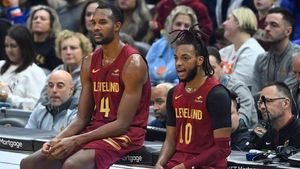Max has announced that season two of the HBO’s Emmy®-winning original drama series The Last of Us will be available to stream in American Sign Language (ASL) alongside the show’s episodes each week beginning with the season debut on Sunday, April 13 at 9:00 p.m. ET. Season one of the series will be available to stream in ASL starting Friday, March 31, just in time for fans to catch up before the eagerly awaited debut of season two.
This marks a significant milestone as it is the first time HBO’s original programming will be available in ASL on Max, following previous successes of Warner Bros. films such as Barbie, Godzilla x Kong: The New Empire, and Beetlejuice. The move underscores Max’s commitment to creating a more accessible streaming experience for all subscribers.
In this ASL rendition of The Last of Us, performances are led by Daniel Durant, celebrated for his role in the Oscar-winning film CODA, and Leila Hanaumi, known for her work at Deaf Austin Theater. Hanaumi also directed the ASL adaptation for the first season. “We are thrilled to expand our ASL program and debut our first HBO Original series in ASL with The Last of Us,” said Naomi Waibel, SVP of Global Product Management at WBD. “This debut brings the show to life in an authentic and fully accessible way for Deaf audiences and is another meaningful step towards our goal of offering an inclusive streaming experience.”
The series, based on the acclaimed video game franchise developed by Naughty Dog for PlayStation® consoles, portrays a post-apocalyptic world where survivors navigate complex emotional landscapes amidst danger. Among its highlights is the careful detailing that goes into the ASL interpretation, ensuring that the intricacies of the narrative resonate with Deaf viewers. As Durant noted, “It gives us expanded ideas and meanings, and then we as Deaf people get to understand the meanings behind it, using our own language and seeing it on the screen. It makes it even more accessible to us and so much more special.”
For the ASL adaptation, techniques have been meticulously refined to enhance visual storytelling. Featuring Durant, who interprets the entirety of the first season, viewers will see him in the corner of the frame, superimposed during the key moments of the show, rather than isolated in a picture-in-picture format. His performance remains seamless, thanks to careful adjustments made by the production team, who ensured that his appearance on camera was consistent and unobtrusive.
One of the creative mindsets behind this adaptation came from Hanaumi’s experience and understanding as both a director and performer. “The translation from one line to another is already a huge hurdle on your brain, but [he’s] also copying their body language and catching the mirroring of each character,” she elaborated, emphasizing the comprehensive nature of the work. This approach not only focuses on the dialogue but also captures the essence of character interactions and story progression, enriching the experience for audiences.
As the ASL version of The Last of Us rolls out, scenes from episodes—including the heavily anticipated moment in Episode 7, where Ellie is introduced to the wonder of neon lights through a derelict mall—get highlighted through Durant's unique gestures. He conveys the sound of power generators rumbling to life and Ellie’s joy as she navigates an unseen world, all expressed through his skilled signing. He uses different signs to illustrate key elements of the story, seamlessly delivering both sides of conversations, often engaging in role-shifting to denote various characters.
The production of the ASL version proved intricate. In some instances, the crew had to create new signs tailored to the context of specific elements in the show while retaining a level of authenticity, ensuring that the rich tapestry of The Last of Us can be grasped fully by its Deaf audiences. Discussing the creative challenges, Hanaumi shared, “The sign for ‘escalator’ has to be made distinct from ‘stairs,’ and we adapt the signs to stay true to the character's intent and emotional depth.”
Durant also underscored the importance of enhancing comprehension through careful presentation of technical terms and context, stating that scientific jargon finds a clearer point of reference through ASL. “It’s just amazing this kind of access is capable now, because it aligns with Deaf people in different work environments and fields. We have more Deaf scientists now, and they are coming up with new ASL signs for scientific terms,” concluded Hanaumi, highlighting the continual progress toward greater availability and understanding.
The commitment to representation on screen does not end with the current adaptations. Durant hopes for wider Deaf representation in all visual media. “The movie CODA, that came out, and for a few years, we did see more opportunities for Deaf people, but then we had the SAG strike, and it became really quiet. I hope there are more Deaf characters that will be written in the future in shows or TV. That is our hope.”
As Max embarks on this promising venture embracing ASL adaptations, the entire reboot will allow the show to resonate deeply with fans old and new. The ASL version of The Last of Us will begin streaming on March 31 and season two on April 13, paving the way for a new chapter in inclusive television.





